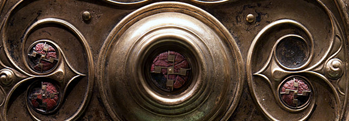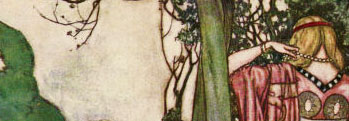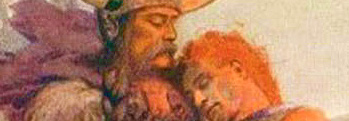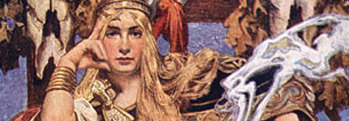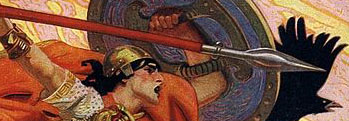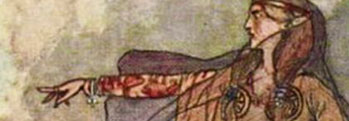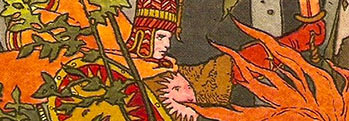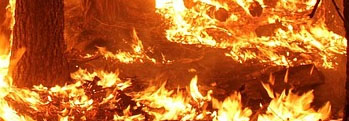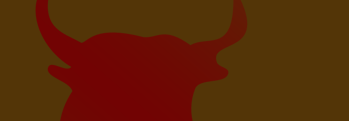How Cuchulainn Was Named
Irish and Celtic myths and legends, Irish folklore and Irish fairy tales from the Ulster Cycle
How Cuchulainn Was Given Nis Name
 It was the time of heroes in ancient Ireland, when giants walked the land, before Fionn MacCumhaill had sent the seven shadows of the Glen back to their dark and restless sleep with his flashing sword, and even before his son Oisín had slain the worm of the lakes, when Setanta was young.
It was the time of heroes in ancient Ireland, when giants walked the land, before Fionn MacCumhaill had sent the seven shadows of the Glen back to their dark and restless sleep with his flashing sword, and even before his son Oisín had slain the worm of the lakes, when Setanta was young.
He it was who became one of the mightiest heroes of all of Ireland, but by then he was not called Setanta any longer! And this is the story of how he got his name.
There was a smith by the name of Chulainn who had in mind to show off some of his wares to the king of Ireland, so he sent an invitation to Emain Macha where the king lived, asking King Conchobar to come and enjoy the hospitality of his household. But, he begged the king, do not bring many with you, for Chulainn despite all his skill was a man of humble means.
King Conchobar agreed and set off later to the hall of Chulainn, and as he was travelling with a few of his court, he happened to stop by a field where the Boys' Troop was playing. Back in those days the warriors of Ireland began their learning at a very young age, and it was tough going too I don't mind telling you!
First the young lads played the game of snatching cloaks, where each boy would try to lift the cloak off the back of the others, and him with the most cloaks was declared the champion. The youth called Setanta took the rest easily, while the other boys were unable to so much as pluck a hair from his head.
Next the king watched them playing tumble-the-wildcat, where the boys would try to knock one another off their feet – and again, it was Setanta left standing! Greatly impressed with this display of youthful vigour, King Conchobar called out to Setanta, telling him to join the king for a feast at Chulainn house. Setanta said he'd catch up with them later, as he wasn't yet done with his playing, paying no heed to the groans rising up from the ground, and although he didn't know the way the king's chariots would leave a wide and clear path for him to follow.
Knowing how important it was for the young men to take their training seriously, King Conchobar agreed and rode off to the hall of Chulainn, taking a seat before the lavish feast the smith had laid on. Just as they were about to start carving slices from the delicious glazed venison and mounded fresh bread with herbal butter drippings, Chulainn asked the king if he was expecting anyone else.
His eyes as full of food as he hoped his belly would soon be, the king replied that he wasn't expecting anyone, forgetting Setanta completely in his hunger. Himself and his small court fell silent then as Chulainn led out a giant beast of a dog to stand before the company.
The hound was as tall as a pony and twice as wide, with bearing and might fit to turn a brave man into a coward, fierce of fang and strong enough to pull a horse behind it. Chulainn explained that as he lived so far outside Emain Macha he had raised and trained the enormous dog from a puppy to protect himself and his small household, and knowing no other man but himself, it would rend to pieces anyone it caught trespassing.
Conchobar, with one eye on the food and the other on the beast bid him let it loose, so it padded outside the hall and circled around the grounds, before laying itself down to gaze with unblinking red eyes at the road.
Now Setanta, knowing nothing of this, had set out from the field where he'd been playing and brought with him only a hurling-stick and a small hard hurling ball, called a sliotar. Hurling was a very popular sport in Ireland in those days, and so it remains today, but there was never a hurler like Setanta! So swift and sure was he that he'd hit the ball as fast as he could, then race to catch up with it before it landed.
So caught up in his chase was he that he was almost upon the hound before he spotted it, and it spotted him! Giving a great bay, the dog leaped to its full height and thundered towards Setanta. Inside the hall the feasting fell silent, and the men knew someone was about to be killed. Remembering Setanta all of a sudden, Conchobar leaped to his feet and rushed outside with an oath.
He was too late – though not for Setanta! For seeing the beast tearing up great clods of earth with its claws as it came for him, he quickly took aim with his hurley and sliotar and eyed it well. With one whack he'd put the ball down the dog's throat, and when it lay upon the ground choking, he'd grabbed hold of its hind legs and dashed its brains out upon a nearby rock!
Well the king and his court were overjoyed to see Setanta alive and well, but poor Chulainn was silently weeping, and he told Setanta that he wasn't welcome in his hall. For who now would protect him from anyone who might wish to take all that he owned?
Although Conchobar took umbrage at these words, Setanta felt sorrow for his deed, and swore he'd make good his slaying of the hound. He asked Chulainn whether or not there was another such hound in all the land, and Chulainn said the dog had a pup – but it would take time to train it.
At that, Setanta promised he'd take the place of the hound and protect Chulainn's house until the pup was full grown. When the Druid Cathbad overheard this, it was as though a light shone on him, and he said from this point on, Cú Chulainn was to be Setanta's name, which means “The Hound of Chulainn”.
And so for the next year, Cúchulainn slept at the front door of Chulainn's home, and circled his house every night, and slept with one eye open to ward off any danger that might arise. Below on the map is marked near to the house of Chulainn.
Further Tales from the Ulster Cycle
Alone in County Louth rises a tall standing stone, its only company the ravens overhead and the whispering wind given voice by nearby trees. This is Clochafarmore, which means "the stone of the great man". It was first raised during the bronze age and rises to ove three meters in height, in a place whose name means The Field of Slaughter, ... [more]
War and the arts of war much occupied the people of Ireland, who became renowned for their skill with weapons and in the ways of battle. They fought one another and the many invaders who came to this land, earning not only fame for their arms and the swords and spears they carried, but for their shields as well! Some of the most legended shields ... [more]
Irish legends have this peculiar property – so long and so often have they been repeated down through the millennia that oftentimes one tale might cross into another, over and back, and leave its track behind. Some stories are far older than they might seem, and some contain shadows and echoes stretching back to the very beginning. Such is ... [more]
Bláthíne, whose name means “little flower” in Irish, was one of the ladies of the Tuatha Dé Danann, that mystical race of warlocks whose hardened red-gold bronze had shimmered in the sunshine when they ruled Ireland. Her beauty was famed throughout this world and the otherworld, but her story is a warning to all who ... [more]
It was often the way in olden times in Ireland that women would fight alongside the men, fierce and unbowed, and accorded the honour of warriors too. So it was with the fearless Scáthach, the legendary Scottish warrior woman whose name meant "the Shadow"! She lived in a sinister castle called Dún Scáith, or the For ... [more]
Many and infamous were the weapons of the tribes of Ireland, and fierce the warriors who wielded them in battle, but few were as notorious as the spear of fire and poison, the Lúin Cheltchair, which thirsted for blood so much that it had to be kept in a cauldron of poison, held down with chains by four foreigners – for who would risk t ... [more]
Cúchulainn, although still a young man, had made many powerful enemies, but none more bitter and dark than Queen Medb of Connaught, whose armies he had routed and whose ambitions he'd thwarted. Long into the dark nights of winter, year after year she brooded on the humiliations visited upon her, for undying is the wrath of a Queen. Sh ... [more]
Queen Medb had invaded Ulster and the lands of the north, thinking it would be an easy victory since the men of Ulster were crippled with birth pangs as a result of a curse place on them, but Cúchulainn had dogged her every step savagely. Attacking her supply wagons, ambushing her men from the trees, burning tents at night, he fought sing ... [more]
Queen Nessa had been known as a gentle and sweet natured woman when she was a maid, but through the hardships of the world she became cold and ruthless. Still, for all that she was still a rare beauty and an indomitable warrior, which many men find to be an irresistible combination! And so it was with King Fergus Mac Ríoch, master of all ... [more]
They say the fury of a storm in a high tempest has nothing on the fury of a woman scorned, and few women have ever felt quite so scorned as Aoife the warrior-queen after she found out that her lover Cúchulainn had married another woman, Emer! She had borne a son for him, but in her wrath she decided to turn the child against him. She spok ... [more]
In the age of heroes, forgotten by all but the storytellers and the legend-weavers, when champions strode the land of Ireland, their halls and Duns now covered in moss, echoing to no songs but those of the blackbird and the red-breasted robin, the people of Ulster were gathered together for a great celebration at Emain Macha, the capital of Ulster. ... [more]
A quarrel arose between Queen Medb of Connacht and the King of Ulster regarding who had the most wealth, but all of his men were cursed with the pains of a pregnant woman giving birth so they couldn't ride out to meet her marching army. Only Cúchulainn who had the blood of the Sidhe running through his veins could even walk, let alone fi ... [more]
Cathbad the Druid was well known throughout the lands of Ireland for his subtle skill and cunning ways, he could make birds speak the language of men and the very stones themselves sing, it was said! But like all Druids, he could also tell the portents of the day, as the ripples may be seen from a rock cast into a still pool in the deepest forest. ... [more]
Cruinniuc was a farmer in the northern part of Ireland back in the days of legend, and often legends are told of heroes and their mighty deeds, but this tale is about humbler folk who change the path of history nonetheless. Cruinniuc wasn't a bad sort but his life had been struck with ill fortune for years – his wife had passed away an ... [more]
The chariot games in Ireland of old were a great event – the mightiest of kings, warriors, princes and champions from around the world would travel from afar to watch and join the fiercely contested races. Each man and his team of horses would thunder round the track, and the cheers of the onlookers would shake the hills. And so it was for ... [more]
It was the time of heroes in ancient Ireland, when giants walked the land, before Fionn MacCumhaill had sent the seven shadows of the Glen back to their dark and restless sleep with his flashing sword, and even before his son Oisín had slain the worm of the lakes, when Setanta was young. He it was who became one of the mightiest heroes of ... [more]
King Aillil, husband to Queen Medb whose famous cattle raid started a war with Cú Chulainn, was deep in his cups as the sun set on Samhain night, red and cloud-torn over the ancient fortress of Rathcroghan. Bothered by the whispering winds, he took a notion that it would be a good test of courage if one of his warriors would go out and put a ... [more]
Bricriu of the venomous tongue he was called, and well named indeed he was, for he loved nothing better than to cause trouble and spread rumours and half-truths to unsettle people. As such he decided to hold a great feast, although he knew that by his reputation few would be interested in attending, so he made a special effort to entice them. He ... [more]
One of the most famed legends of old is that of the war that was fought over the Brown Bull of Cualgne. Now while it might seem an odd thing for us today to think of a war fought over a bull, the matter is not so simple as it might seem, and the bull was no ordinary bull either! For it was in the time of Cú Chulainn, the hound of Chulainn, t ... [more]





